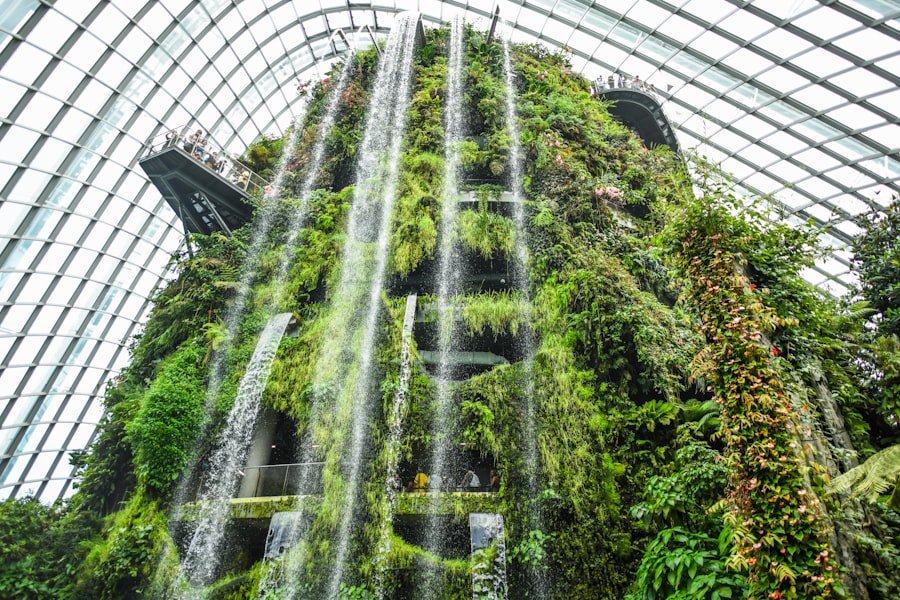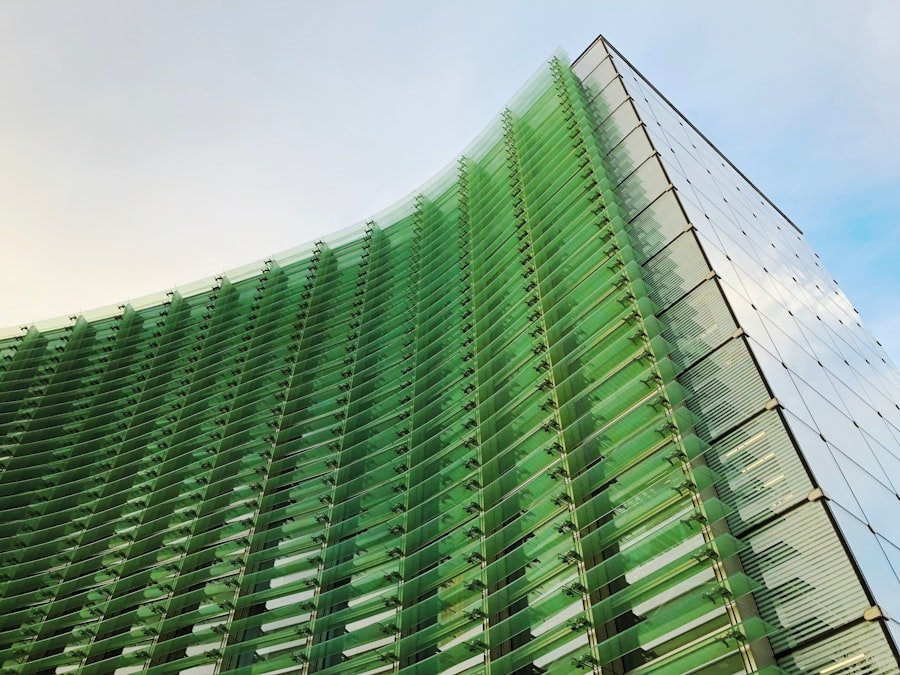Sustainable architecture is an evolving discipline that seeks to create buildings and environments that are not only functional and aesthetically pleasing but also environmentally responsible and resource-efficient throughout their life cycle. This approach to design emerged in response to the growing awareness of environmental issues, such as climate change, resource depletion, and urban sprawl. As the global population continues to rise, the demand for housing and infrastructure increases, placing immense pressure on natural resources.
Sustainable architecture aims to mitigate these impacts by integrating ecological principles into the design and construction processes. The concept of sustainability in architecture encompasses a wide range of practices, from energy-efficient building designs to the use of renewable materials. It involves a holistic approach that considers the environmental, social, and economic aspects of building projects.
By prioritising sustainability, architects and builders can create spaces that not only meet the needs of their occupants but also contribute positively to the surrounding ecosystem. This paradigm shift in architecture is not merely a trend; it represents a fundamental change in how we think about the built environment and its relationship with nature.
Summary
- Sustainable architecture focuses on creating buildings and structures that are environmentally responsible and resource-efficient.
- Principles of sustainable architecture include energy efficiency, use of sustainable materials, and consideration of the building’s impact on the surrounding environment.
- Benefits of sustainable architecture include reduced energy consumption, lower operating costs, and improved indoor air quality.
- Examples of sustainable architecture include green buildings, passive solar design, and use of recycled materials in construction.
- Challenges and limitations of sustainable architecture include higher initial costs, limited availability of sustainable materials, and the need for specialised knowledge and skills in design and construction.
Principles of Sustainable Architecture
At the core of sustainable architecture are several key principles that guide the design process. One of the most fundamental is the concept of energy efficiency. Buildings consume a significant amount of energy for heating, cooling, lighting, and other operational needs.
By designing structures that minimise energy consumption through passive solar design, natural ventilation, and high-performance insulation, architects can significantly reduce a building’s carbon footprint. For instance, orienting a building to maximise natural light can decrease reliance on artificial lighting, while strategically placed windows can enhance cross-ventilation, reducing the need for mechanical cooling systems. Another essential principle is the use of sustainable materials.
This involves selecting resources that are renewable, recyclable, or have a low environmental impact. For example, bamboo is increasingly favoured in sustainable construction due to its rapid growth rate and strength. Additionally, reclaimed wood from deconstructed buildings can be repurposed for new projects, reducing waste and conserving resources.
The choice of materials extends beyond their physical properties; it also encompasses their sourcing and production processes. Sustainable architecture advocates for local sourcing to minimise transportation emissions and support local economies.
Benefits of Sustainable Architecture

The benefits of sustainable architecture extend far beyond environmental considerations. One significant advantage is the potential for cost savings over the life cycle of a building. While initial construction costs may be higher due to the use of sustainable materials and technologies, the long-term savings from reduced energy bills can be substantial.
For instance, buildings designed with energy-efficient systems often see a reduction in operational costs by as much as 30-50%. This financial incentive encourages both developers and homeowners to invest in sustainable practices. Moreover, sustainable architecture contributes to improved health and well-being for occupants.
Buildings designed with natural light, good air quality, and access to green spaces have been shown to enhance productivity and reduce stress levels. Research indicates that occupants of green buildings report higher satisfaction levels and lower incidences of health issues such as respiratory problems. The integration of biophilic design elements—such as indoor plants or views of nature—further promotes a sense of connection to the environment, which is increasingly recognised as vital for mental health.
Examples of Sustainable Architecture
Numerous exemplary projects around the world showcase the principles of sustainable architecture in action. One notable example is the Bosco Verticale (Vertical Forest) in Milan, Italy. This residential complex features two towers adorned with over 9,000 trees and 20,000 plants, creating a vertical forest that helps combat urban pollution while providing residents with green space.
The design not only enhances biodiversity but also improves air quality and reduces energy consumption by providing natural insulation. Another remarkable project is the Bullitt Center in Seattle, Washington, often referred to as the “greenest commercial building in the world.” This six-storey structure is designed to be self-sufficient in energy and water. It features a solar array that generates more energy than it consumes over the course of a year and a rainwater harvesting system that meets all its water needs.
The Bullitt Center serves as a model for future commercial developments by demonstrating that sustainability can be both practical and economically viable.
Challenges and Limitations of Sustainable Architecture
Despite its many advantages, sustainable architecture faces several challenges and limitations that can hinder its widespread adoption. One significant barrier is the perception that sustainable building practices are prohibitively expensive. While it is true that some sustainable materials and technologies may have higher upfront costs, this perception often overlooks the long-term savings associated with reduced energy consumption and maintenance costs.
Educating stakeholders about the financial benefits of sustainable architecture is crucial for overcoming this hurdle. Additionally, there are technical challenges related to integrating sustainable practices into existing building codes and regulations. Many jurisdictions have outdated codes that do not accommodate innovative sustainable technologies or materials.
This can create obstacles for architects and builders who wish to implement cutting-edge solutions. Advocacy for updated regulations that support sustainable practices is essential for fostering an environment where sustainable architecture can thrive.
Sustainable Materials and Construction Techniques

The selection of materials plays a pivotal role in sustainable architecture, influencing both environmental impact and building performance. Sustainable materials are characterised by their low embodied energy—meaning they require less energy to produce—and their ability to be recycled or reused at the end of their life cycle. For instance, materials such as rammed earth or straw bales are gaining popularity due to their minimal environmental impact and excellent thermal properties.
Construction techniques also contribute significantly to sustainability. Prefabrication is one method that has gained traction in recent years; it involves manufacturing building components off-site in controlled environments before transporting them to the construction site for assembly. This approach reduces waste, minimises construction time, and often results in higher quality control compared to traditional on-site construction methods.
Additionally, techniques such as green roofing—where vegetation is planted on rooftops—can improve insulation, reduce stormwater runoff, and enhance urban biodiversity.
Sustainable Design and Planning Strategies
Sustainable architecture extends beyond individual buildings; it encompasses broader design and planning strategies that consider entire communities and urban environments. One effective strategy is mixed-use development, which combines residential, commercial, and recreational spaces within close proximity. This approach reduces reliance on cars by promoting walkability and public transport use, thereby decreasing greenhouse gas emissions associated with transportation.
Another critical aspect of sustainable planning is the preservation of natural landscapes and ecosystems during development projects. Integrating green spaces into urban areas not only enhances aesthetic appeal but also provides essential habitats for wildlife and contributes to improved air quality. Urban planners are increasingly recognising the importance of incorporating nature into city designs through parks, green corridors, and community gardens.
The Future of Sustainable Architecture
The future of sustainable architecture appears promising as technological advancements continue to emerge alongside growing public awareness of environmental issues. Innovations such as smart building technologies are revolutionising how we manage energy consumption within buildings. These systems utilise sensors and automation to optimise heating, cooling, lighting, and other operational functions based on real-time data, leading to significant energy savings.
Furthermore, as climate change becomes an increasingly pressing concern, there is a growing emphasis on resilience in architectural design. Future buildings will need to withstand extreme weather events while maintaining functionality and comfort for occupants. This shift towards resilience will likely drive further innovation in materials and design strategies that prioritise adaptability and sustainability.
In conclusion, sustainable architecture represents a vital response to contemporary environmental challenges while offering numerous benefits for individuals and communities alike. As awareness grows and technology advances, it is expected that sustainable practices will become more integrated into mainstream architectural design, paving the way for a more environmentally conscious built environment.
Sustainable architecture is a crucial aspect of modern urban planning, focusing on creating environmentally friendly and energy-efficient buildings. A related article that delves into the importance of sustainability in various industries is Wellbeing in the Workplace. This article explores how companies can promote employee health and happiness through sustainable practices, ultimately leading to a more productive and engaged workforce. By incorporating sustainable architecture principles into office design, businesses can create a healthier and more sustainable work environment for their employees.
FAQs
What is sustainable architecture?
Sustainable architecture is a design approach that aims to minimize the environmental impact of buildings and infrastructure while creating healthy, energy-efficient spaces for people to live and work in.
What are the key principles of sustainable architecture?
Key principles of sustainable architecture include using renewable and recyclable materials, minimizing energy consumption, optimizing natural light and ventilation, and integrating green spaces and water conservation systems.
How does sustainable architecture benefit the environment?
Sustainable architecture benefits the environment by reducing carbon emissions, conserving natural resources, and minimizing waste production. It also helps to mitigate the urban heat island effect and promotes biodiversity in urban areas.
What are some examples of sustainable architecture features?
Examples of sustainable architecture features include green roofs, solar panels, rainwater harvesting systems, passive heating and cooling techniques, and the use of locally-sourced and recycled materials.
How does sustainable architecture contribute to human well-being?
Sustainable architecture contributes to human well-being by creating healthier indoor environments with improved air quality, natural light, and thermal comfort. It also promotes physical activity and mental well-being through the integration of green spaces and biophilic design principles.
